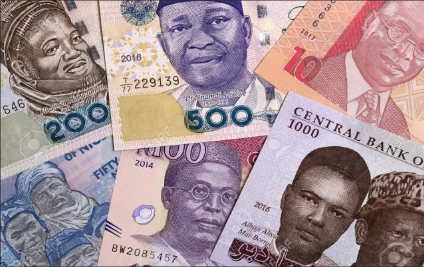Report on Nigeria's Economic Variable Correlation and Productivity Model
 Ayodele Adeniyi
Ayodele Adeniyi
Below is a detailed report on economic variable correlation and productivity model for Nigeria.
- Relevant data such as M1 money supply, Exchange rate, Inflation, Stock Market, and their individual growth rate were gathered online and merged into an excel file for easy compilation. The dataset spans over a period of 20 years i.e. from 2004 till 2024. The excel file was imported into a Jupyter notebook for further analysis using Python.
The dataset consists of the headers listed above, here is a snippet of the first few rows of the data.
- The four (4) key variables of the analysis were visualized with a line chart showing the trend over time in a space of four years intervals. here are the visualizations:
From the charts above we see these:
Inflation: From the chart, we see an increased progression of inflation over the years with some deeps occurring in some of the years, but an inclined inflation generally.
Stock Market: The stock market has not witnessed the same progression as the inflation, but from the chart, it can be seen that it rose to a certain value and then dipped around 2008 with a very noticeable spike in 2024.
M1 Money Supply: From the chart, we see a gradual and steady progression in the supply of money from 2004 to 2024. The value as of May 2024 being 33382632.88 million.
Exchange Rate: The exchange rate fairly rose between 2004 and 2016 but began to be very significant in the ensuing years with 2024 witnessing a spike in the value of exchange rate that is approximately #1,600 for a dollar.
Correlation was done for the four variables to determine the relationship between them to note to what extent this relationship is as it would further help in noting which variable can cause a significant change in the economy if affected. Below is the correlation matrix for the variables:
- M1 and Exchange Rate: High positive correlation with a value of 0.85 is seen, this suggests that as the money supply increases, the exchange rate tends to increase. A strong positive correlation of 0.85 suggests that increases in the M1 money supply (a measure of the amount of money in circulation) are associated with increases in the exchange rate.
Example: If the M1 supply increases due to central bank policies, the exchange rate might rise, making the domestic currency stronger compared to foreign currencies.
- M1 and Inflation: A moderate positive correlation of 0.67 is observed, coupled with other factors, we can say that increased money supply is associated with higher inflation. A moderate positive correlation of 0.67 indicates that increases in M1 are associated with rising inflation rates, though the relationship is not as strong as with the exchange rate.
Example: When more money is in circulation (M1 increases), consumers have more to spend, which can drive up prices, leading to inflation.
- M1 and Stock Market: A moderate positive correlation of 0.67 is also seen here, increased money supply is associated with higher stock market values.
Example: With more money available in the economy, investors might have more funds to invest in the stock market, driving up stock prices.
- Exchange Rate and Inflation: A significant positive correlation of 0.71 is observed, higher exchange rates (currency appreciation) are associated with higher inflation.
Example: A higher exchange rate (stronger domestic currency) might increase the cost of imports, contributing to inflation if imported goods become more expensive.
- Exchange Rate and Stock Market: High positive correlation of 0.78 is seen, higher exchange rates are associated with higher stock market values.
Example: A stronger domestic currency (higher exchange rate) can attract foreign investment into the stock market, driving up stock prices.
- Inflation and Stock Market: A moderate correlation score of 0.49 is seen, higher inflation is associated with higher market values.
Example: While inflation can sometimes drive stock prices up (as companies raise prices and increase revenues), it can also have a negative impact if it leads to higher costs and reduced consumer spending.
- Further analysis was done to figure out the time shifted correlations between these variables.
A time shift correlation refers to the comparison of two signals by examining their similarity at different time offsets. It helps determine whether one signal leads or lags behind the other.
Time-Shifted Correlation: Measures how the correlation between two variables changes when one variable is shifted in time relative to the other.
Lag (months): The x-axis represents the time shift in months. A positive lag means shifting the variable to the right (future), and a negative lag means shifting the variable to the left (past).
Below are the charts for the time shifted correlations:
M1: Correlation of M1 with itself is always 1 (blue line at 1.0).
Exchange Rate (orange): Correlation with M1 is relatively high and remains stable over time.
Inflation (green): Shows an increasing correlation with M1 as time moves forward.
Stock Market (red): Displays a weaker correlation with M1, with some fluctuations.
Exchange Rate: Correlation with itself is always 1 (orange line at 1.0).
M1 (blue): High correlation that increases slightly as the lag moves forward.
Inflation (green): Correlation increases with future lags.
Stock Market (red): Shows a varying correlation that peaks around 5-6 months into the future.
Inflation: Correlation with itself is always 1 (green line at 1.0).
M1 (blue): Increasing correlation as lag moves forward.
Exchange Rate (orange): Shows a moderate and stable correlation over time.
Stock Market (red): Weaker correlation that decreases slightly over time.
Stock Market: Correlation with itself is always 1 (red line at 1.0).
M1 (blue): Increasing correlation up to a point and then decreasing as lag increases.
Exchange Rate (orange): Shows a peak in correlation around 5-6 months and then decreases.
Inflation (green): Fluctuates but generally shows an increasing trend with time.
SUMMARY
M1 money supply tends to have an increasing correlation with inflation and the stock market as time moves forward.
Exchange rates show strong correlations with M1 and the stock market, peaking at certain lags.
Inflation's correlation with other variables generally increases over time.
The stock market's correlation with M1 and exchange rates peaks at certain lags before decreasing.
Theoretical Framework on what increased money supply can lead to
- Baseline productivity level
If the productivity level (output per unit of input) remains constant while the money supply increases, the extra money chases the same amount of goods and services, leading to higher prices (inflation) and other effects described above. However, if productivity increases in line with the money supply, the effects on inflation and currency depreciation might be mitigated, as the increased output can absorb the extra money.
Currency Depreciation: Increased money supply can lead to currency depreciation due to inflation expectations, lower interest rates, and decreased demand for the currency.
Stock Market Appreciation: The stock market might appreciate due to lower interest rates, increased liquidity, and stocks being seen as an inflation hedge.
Increased Inflation: More money in circulation can lead to demand-pull and cost-push inflation, as well as monetary inflation due to reduced purchasing power of the currency.
Productivity model
productivity can be seen generally as the ratio of the output to the input. to develop a productivity model combining the three variables M1 supply, Stock market, and Inflation, the formula:
Productivity = Stock Market (M1 money supply * Inflation)
Stock Market is an output proxy, whilst (M1 Money Supply * Inflation) is serving as an input proxy.
When this model was incorporated into the dataset a productivity score of 16.48% was returned. The model was also visualized using a line trend over the years, the chart below was the output.
Here we see the productivity trend over the years from 2204 till 2024, productivity was at its peak around 2006, and a gradual descent can be seen in later years which is more pronounced from 2016 till date. It can be analyzed that productivity is slightly decreasing.
- Baseline productivity.
A stable period was assumed for the dataset to serve as a reference for the baseline productivity as shown in the code snippet below
# Determine a stable period for baseline calculation
# Assume the first 5 years in the dataset are considered stable
stable_period = data[data['DATE'] < pd.to_datetime('2005-01-01')]
# Calculate baseline productivity
baseline_productivity = stable_period['Productivity'].mean()
print("Baseline Productivity:", baseline_productivity)
The years were considered stable because the metrics or variables in use were relatively at their lowest during the early years. Below is the chart for the baseline productivity.
It can be seen that ensuing years did not witness a rise in productivity as inflation alongside other variables have significantly inhibited productivity.
- Currency Devaluation
The mean of M1 money supply (reference_m1_growth) and Baseline productivity (reference_productivity) were taken and the value for currency devaluation was calculated with the formula:
Real currency devaluation = ExchangeRatereference_productivity - reference_m1_growth
This was inserted into the model and a score of -678581876.9229803 was returned showing a substantial devaluation of the Naira.
Below is the chart for Real currency devaluation.
Here we see a progressive devaluation of the Naira over the years with a significant spike in 2024.
In conclusion, this comprehensive analysis provides valuable insights into the interactions between key economic variables in Nigeria. The data shows that the M1 money supply, exchange rates, stock market performance, and inflation rates are interconnected and significantly influenced by monetary policies and economic events.
You can view the codes for the analysis on my Github repository here.
You can also connect with me on LinkedIn for more collaborations, thank you.
Subscribe to my newsletter
Read articles from Ayodele Adeniyi directly inside your inbox. Subscribe to the newsletter, and don't miss out.
Written by

Ayodele Adeniyi
Ayodele Adeniyi
I am a certified data analyst with extensive experience working with datasets across various niches and sectors. My passion for data analytics stems from a desire to contribute to the technological ecosystem by enabling organizations leverage data for informed decision-making that drives growth. I am proficient in using tools such as Excel, PowerBI, SQL, Tableau, and Python to derive valuable insights. When I am not deriving insights from data, I enjoy playing chess and engaging in thoughtful discussions to share opinions and perspectives with others. Welcome to my blog, where you will find projects I have undertaken both individually and collaboratively with other teams.